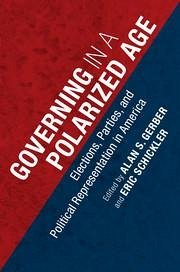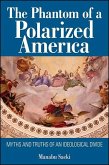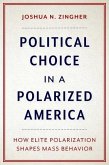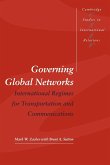Governing in a Polarized Age
Elections, Parties, and Political Representation in America
Herausgeber: Gerber, Alan S; Schickler, Eric
Governing in a Polarized Age
Elections, Parties, and Political Representation in America
Herausgeber: Gerber, Alan S; Schickler, Eric
- Broschiertes Buch
- Merkliste
- Auf die Merkliste
- Bewerten Bewerten
- Teilen
- Produkt teilen
- Produkterinnerung
- Produkterinnerung
This volume provides an in-depth examination of representation and legislative performance in contemporary American politics.
Andere Kunden interessierten sich auch für
![Governing in the Internet Age Governing in the Internet Age]() Paul FletcherGoverning in the Internet Age23,99 €
Paul FletcherGoverning in the Internet Age23,99 €![The Phantom of a Polarized America The Phantom of a Polarized America]() Manabu SaekiThe Phantom of a Polarized America39,99 €
Manabu SaekiThe Phantom of a Polarized America39,99 €![Governing and Governance in France Governing and Governance in France]() Alistair ColeGoverning and Governance in France34,99 €
Alistair ColeGoverning and Governance in France34,99 €![Governing with Words Governing with Words]() Daniel Q. GillionGoverning with Words26,99 €
Daniel Q. GillionGoverning with Words26,99 €![Political Choice in a Polarized America Political Choice in a Polarized America]() Joshua N ZingherPolitical Choice in a Polarized America40,99 €
Joshua N ZingherPolitical Choice in a Polarized America40,99 €![Governing Global Networks Governing Global Networks]() Mark W. ZacherGoverning Global Networks36,99 €
Mark W. ZacherGoverning Global Networks36,99 €![Governing in the Shadows Governing in the Shadows]() Paula Cristina RoqueGoverning in the Shadows37,99 €
Paula Cristina RoqueGoverning in the Shadows37,99 €-
-
-
This volume provides an in-depth examination of representation and legislative performance in contemporary American politics.
Hinweis: Dieser Artikel kann nur an eine deutsche Lieferadresse ausgeliefert werden.
Hinweis: Dieser Artikel kann nur an eine deutsche Lieferadresse ausgeliefert werden.
Produktdetails
- Produktdetails
- Verlag: Cambridge University Press
- Seitenzahl: 406
- Erscheinungstermin: 31. Oktober 2016
- Englisch
- Abmessung: 232mm x 154mm x 24mm
- Gewicht: 553g
- ISBN-13: 9781107479074
- ISBN-10: 110747907X
- Artikelnr.: 45019101
- Herstellerkennzeichnung
- Libri GmbH
- Europaallee 1
- 36244 Bad Hersfeld
- gpsr@libri.de
- Verlag: Cambridge University Press
- Seitenzahl: 406
- Erscheinungstermin: 31. Oktober 2016
- Englisch
- Abmessung: 232mm x 154mm x 24mm
- Gewicht: 553g
- ISBN-13: 9781107479074
- ISBN-10: 110747907X
- Artikelnr.: 45019101
- Herstellerkennzeichnung
- Libri GmbH
- Europaallee 1
- 36244 Bad Hersfeld
- gpsr@libri.de
1. Introduction; Part I. Political Representation and Democratic
Accountability: 2. The electoral connection, age 40 R. Douglas Arnold; 3.
The electoral connection, then and now Gary Jacobson; 4. The congressional
incumbency advantage over sixty years: measurement, trends, and
implications Robert S. Erikson; 5. A baseline for incumbency effects
Christopher Achen; Part II. Continuity and Change in Party Organizations:
6. Legislative parties in an era of alternating majorities Frances E. Lee;
7. Parties within parties: parties, factions, and coordinated politics,
1900-80 John Mark Hansen, Shigeo Hirano and James M. Snyder, Jr; 8. Where
measures meet history: party polarization during the New Deal and Fair Deal
Joshua D. Clinton, Ira Katznelson and John S. Lapinski; Part III.
Partisanship and Governmental Performance: 9. Polarized we govern? Sarah
Binder; 10. What has Congress done? Stephen Ansolabehere, Maxwell Palmer
and Benjamin Schneer; 11. Can Congress do policy analysis? The politics of
problem solving on Capitol Hill Eric M. Patashnik and Justin Peck; 12.
Studying contingency systematically Katherine Levine Einstein and Jennifer
Hochschild; 13. Majoritarianism, majoritarian tension, and the Reed
revolution Keith Krehbiel; Part IV. Conclusions: 14. Intensified
partisanship in congress: institutional effects David E. Price; 15. The
origins of Congress: The Electoral Connection David R. Mayhew.
Accountability: 2. The electoral connection, age 40 R. Douglas Arnold; 3.
The electoral connection, then and now Gary Jacobson; 4. The congressional
incumbency advantage over sixty years: measurement, trends, and
implications Robert S. Erikson; 5. A baseline for incumbency effects
Christopher Achen; Part II. Continuity and Change in Party Organizations:
6. Legislative parties in an era of alternating majorities Frances E. Lee;
7. Parties within parties: parties, factions, and coordinated politics,
1900-80 John Mark Hansen, Shigeo Hirano and James M. Snyder, Jr; 8. Where
measures meet history: party polarization during the New Deal and Fair Deal
Joshua D. Clinton, Ira Katznelson and John S. Lapinski; Part III.
Partisanship and Governmental Performance: 9. Polarized we govern? Sarah
Binder; 10. What has Congress done? Stephen Ansolabehere, Maxwell Palmer
and Benjamin Schneer; 11. Can Congress do policy analysis? The politics of
problem solving on Capitol Hill Eric M. Patashnik and Justin Peck; 12.
Studying contingency systematically Katherine Levine Einstein and Jennifer
Hochschild; 13. Majoritarianism, majoritarian tension, and the Reed
revolution Keith Krehbiel; Part IV. Conclusions: 14. Intensified
partisanship in congress: institutional effects David E. Price; 15. The
origins of Congress: The Electoral Connection David R. Mayhew.
1. Introduction; Part I. Political Representation and Democratic
Accountability: 2. The electoral connection, age 40 R. Douglas Arnold; 3.
The electoral connection, then and now Gary Jacobson; 4. The congressional
incumbency advantage over sixty years: measurement, trends, and
implications Robert S. Erikson; 5. A baseline for incumbency effects
Christopher Achen; Part II. Continuity and Change in Party Organizations:
6. Legislative parties in an era of alternating majorities Frances E. Lee;
7. Parties within parties: parties, factions, and coordinated politics,
1900-80 John Mark Hansen, Shigeo Hirano and James M. Snyder, Jr; 8. Where
measures meet history: party polarization during the New Deal and Fair Deal
Joshua D. Clinton, Ira Katznelson and John S. Lapinski; Part III.
Partisanship and Governmental Performance: 9. Polarized we govern? Sarah
Binder; 10. What has Congress done? Stephen Ansolabehere, Maxwell Palmer
and Benjamin Schneer; 11. Can Congress do policy analysis? The politics of
problem solving on Capitol Hill Eric M. Patashnik and Justin Peck; 12.
Studying contingency systematically Katherine Levine Einstein and Jennifer
Hochschild; 13. Majoritarianism, majoritarian tension, and the Reed
revolution Keith Krehbiel; Part IV. Conclusions: 14. Intensified
partisanship in congress: institutional effects David E. Price; 15. The
origins of Congress: The Electoral Connection David R. Mayhew.
Accountability: 2. The electoral connection, age 40 R. Douglas Arnold; 3.
The electoral connection, then and now Gary Jacobson; 4. The congressional
incumbency advantage over sixty years: measurement, trends, and
implications Robert S. Erikson; 5. A baseline for incumbency effects
Christopher Achen; Part II. Continuity and Change in Party Organizations:
6. Legislative parties in an era of alternating majorities Frances E. Lee;
7. Parties within parties: parties, factions, and coordinated politics,
1900-80 John Mark Hansen, Shigeo Hirano and James M. Snyder, Jr; 8. Where
measures meet history: party polarization during the New Deal and Fair Deal
Joshua D. Clinton, Ira Katznelson and John S. Lapinski; Part III.
Partisanship and Governmental Performance: 9. Polarized we govern? Sarah
Binder; 10. What has Congress done? Stephen Ansolabehere, Maxwell Palmer
and Benjamin Schneer; 11. Can Congress do policy analysis? The politics of
problem solving on Capitol Hill Eric M. Patashnik and Justin Peck; 12.
Studying contingency systematically Katherine Levine Einstein and Jennifer
Hochschild; 13. Majoritarianism, majoritarian tension, and the Reed
revolution Keith Krehbiel; Part IV. Conclusions: 14. Intensified
partisanship in congress: institutional effects David E. Price; 15. The
origins of Congress: The Electoral Connection David R. Mayhew.








